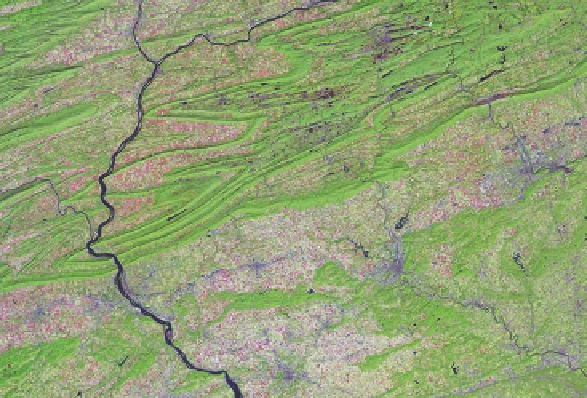Geoscience Reference
In-Depth Information
As far as the growth of mountains is concerned, they
typically form during a distinct interval of time called an
orogeny
. Many excellent examples occur on Earth of how
continental collision and compression cause orogenies in
which rocks are intensively folded. One such example is
the Appalachian Mountains, which extend approximately
2500 km (~1600 mi) along the eastern United States. Several
phases of mountain building have occurred in this region,
including the
Taconic Orogeny
(~450 million years ago),
Acadian Orogeny
(~375 million years ago), and
Allegheny
Orogeny
(~290 to 248 million years ago).
Given that the Allegheny Orogeny occurred most recently,
it is the best understood because the modern landforms are
remnants from that time. It also appears to have impacted the
most extensive area, ranging from what is now Pennsylvania
to Alabama. This area was intensively folded when the north-
west corner of Africa collided with the east coast of North
America at the time Pangaea formed. Geologists believe that
rugged mountains formed during this interval of time that
may have been between 5000 m and 8000 m (~16,400 ft and
26,200 ft) high. In other words, if you could go back to that
time, you would see mountains in what is now Virginia that
looked much like the modern Rocky Mountains in Colorado,
or maybe even the modern Himalayas in Tibet. Over the past
200 million years these once towering mountains have been
eroded to well-rounded landforms, such as those seen in the
Great Smoky Mountains in North Carolina, that are less than
2000 m (6550 ft) high.
The Appalachian Mountains are subdivided into several
different subregions. Perhaps the best known of these regions
is the Ridge and Valley Province, which extends along much
of the length of the Appalachian range. As the name implies,
the landscape here consists of a series of prominent ridges
and intervening valleys. Figure 13.13a shows a satellite view
of this pattern. A characteristic ground-level view is seen in
Figure 13.13b.
When you look at the Appalachian landscape, it is
tempting to assume that the ridges are anticlines because
they arch up and the valleys are synclines because they bend
downward. However, the relationship of surface landforms
and the underlying geologic structure is often much more
complex than you might think. It is well beyond the scope
of this text to examine every such complexity, but to see
some simple examples, look at Figure 13.14. This diagram
shows a general time sequence illustrating how portions of
the landscape evolved. Part (a) reflects what the topography
might have looked like after it was initially folded during
the Allegheny Orogeny. As you would expect, the landscape
at that time consisted of well-developed ridges underlain by
structural anticlines and prominent valleys associated with
the synclines.
40 N
Appalachian
Mountains
Atlantic
Ocean
35 N
Ridge and
Valley Province
30 N
87 W
Susquehanna
River
(a)
(b)
Figure 13.13 Appalachian Ridge and Valley.
(a) Infrared satel-
lite image of a portion of the Ridge and Valley Province in central
Pennsylvania. The ridges (arrows) are covered by forest, which
makes them stand out particularly well. (b) Oblique air photo-
graph of the Ridge and Valley Province. Note the well-developed
ridges and intervening valleys in this panoramic image.
The expected relationship between the shape of the Earth's
surface and the underlying structure began to change in some
cases due to the behavior of streams. Notice in Figure 13.14a
how a network of parallel streams developed on the land-
scape after it was compressed. Do you see how the path of
streams follows the structure? These streams began to vigor-
ously erode the uplifted ridges, but they did so at variable rates
that depended on the resistance (or hardness) of the rocks on
which they flowed. The behavior of streams will be discussed
in more detail in Chapter 16, but, for now, understand that
streams erode some rocks (such as shale) more easily than
A period of mountain building, such as the Allegheny
Orogeny
Orogeny.























